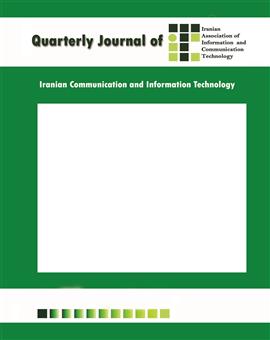Parametric analysis of a broadband Archimedean spiral antenna with cavity
Subject Areas : GeneralHamed noroozy 1 * , Shahrokh jam 2
1 -
2 -
Keywords: Archimedean spiral antenna, cavity, broadband antenna, gain, babinet principle,
Abstract :
In this article an Archimedean spiral antenna is designed and analyzed that has good operation in broadband application. By analyzing this design, the effects that different parameters have on antenna operation will be studied and ways of optimization will be found. Influences of cavity height and number of turns to obtain good matching and gain in a frequency interval of 4 to 18 GHz will be discussed. In addition, using cavity wall around the antenna, side lobes are decreased or deleted. By tapering the arms at feeding center, better matching will be attained. For making S11 bandwidth better, increasing the cavity height or reducing the number of turns can be used. Changing number of turns does not have a significant effect on the gain. To improve the antenna gain, the cavity height needs to be adjusted such that the reflected wave from cavity and radiated wave from spiral arms are constructing.
D. J. Müller and K. Sarabandi, “Design and analysis of a 3-arm spiral antenna,” IEEE Trans. Antennas Propag., vol. 55, no. 2, pp. 258–266, 2007.
[2] D. Zhou, S. Gao, R. a Abd-Alhameed, C. Zhang, M. S. Alkhambashi, and J. D. Xu, “Design and optimisation of compact hybrid quadrifilar helical-spiral
antenna in GPS applications using Genetic Algorithm”, 6th European Conference on Antennas and Propagation (EUCAP), Prague , pp. 1–4, 2012. [3] U. R. Kraft, “Optimisation of circular polarisation performance for 4-arm planar spiral antenna with non perfect excitation networks,” Microwaves, Antennas and Propagation, IEE Proceedings H, vol. 137, no. 1, pp. 45–50, 2011.
[4] F. C. Shire, A.M. Seman, “Parametric Studies of Archimedean Spiral Antenna for UWB Applications”, IEEE Asia-Pacific Conference, Johor Bahru, pp. 275–278, 2014.
[5] H. Wheeler, “The radiansphere aturn a small antenna”, Proc. IRE, vol. 47, no. 8, pp. 1325–1331, 1959.
[6] H. G. Booker, “Slot aerials and their relation to complementary wire aerials (Babinet’s principle),” J. Inst. Electr. Eng. - Part IIIA Radiolocation, vol. 93, no. 4, p. 620, 1946.
[7] P. C. Werntz and W. L. Stutzman, “Design, analysis and construction of an Archimedean spiral antenna and feed structure,” in Southeastcon’89. Proceedings. Energy and Information Technologies in the Southeast, pp. 308–313, 1989.

